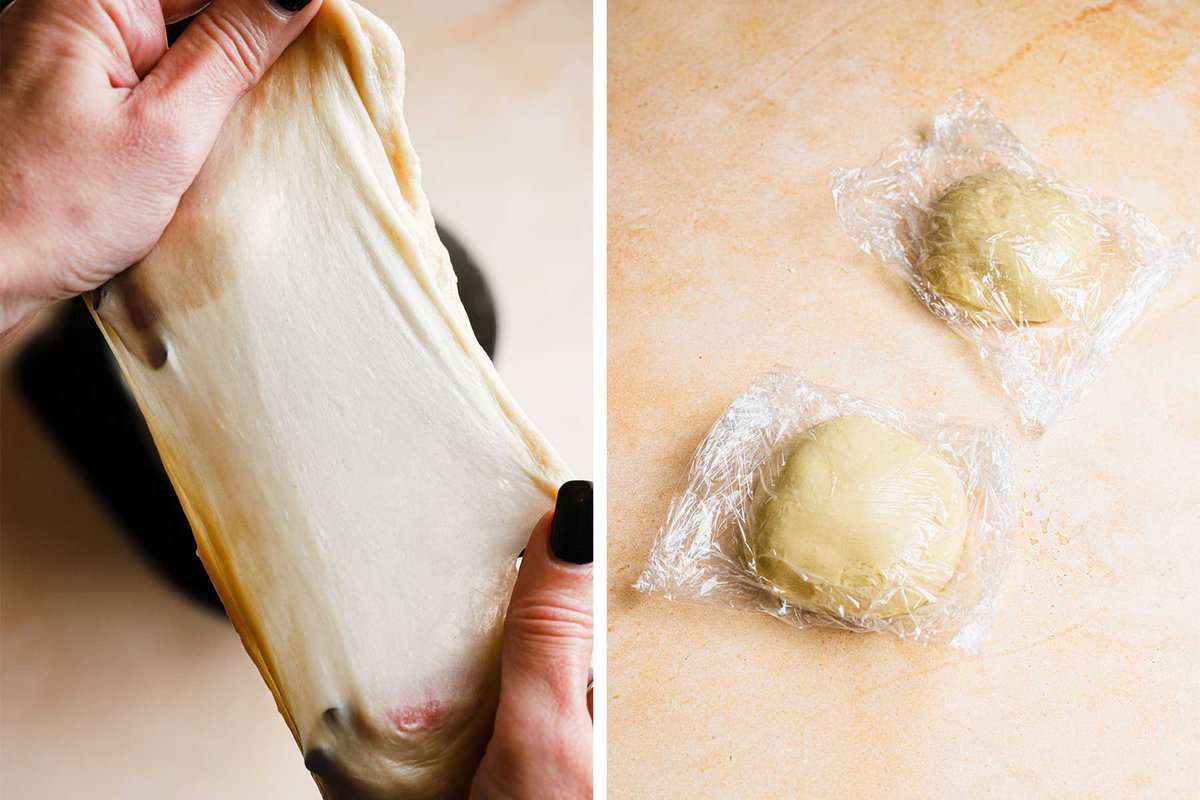Portuguese croissants, also known as “croissants Português” (Porto croissants), are a delightful twist on the classic French pastry. Bursting with flavor and a unique texture, these pastries are sure to captivate your taste buds. Let’s embark on a culinary journey to master the art of Portuguese croissant making!

Portuguese Croissãs Why You Will Love Them?
While the classic French croissant and Italian Cornetto are light and flaky, in Portugal, these rolls go by the name Croissant Brioche. Made with a rich buttery Brioche dough, then rolled and shaped into the classic crescent croissant shape. After baking, the rolls are soaked in sweet, sticky syrup that sometimes is infused with Port Wine.
These pastries will blow your mind! I don’t understand how pastry shops have yet to discover them. They are tender, buttery, a little sticky, slightly sweet, and are the perfect way to help you warm up during your coffee break for that time of the day. Parisian croissants get all the credit, but the Lisbon locals will agree with me that these sweet pastries are love at first bite and the best thing since Brioche Bread.
Portuguese Croissants vs. Classic Croissants
Plain croissants and Cornetti dough go through the classic lamination process, using a block of cold butter and 3-4 dough folds, depending on the recipe. The lamination process for Portuguese croissants is super simple and straightforward (and is even optional). It happens during the shaping stage and only calls for a thin layer of soft butter. I folded the dough twice for extra layers, but you can fold it once or use the same technique I used to make these Brioche Croissants.
Ingredients
To embark on your Portuguese croissant adventure, gather the following ingredients:
For The Croissants
- All-purpose wheat flour. Make sure you only use unbleached all-purpose flour.
- Bread flour. If you do not have any, use all unbleached purpose flour.
- Unsalted soft butter (high quality is key!). Do not use salted butter.
- Cold water or milk. Make sure not to use warm milk or water.
- Sugar
- Salt
- Instant yeast
- Eggs.
- Beaten egg. To brush the croissants.
For The Syrup
The syrup is optional, but I think it adds another sticky layer and sweetness.
- Water
- Sugar
- Vanilla extract
- Port wine (optional)

How to Make Portuguese croissants
Make The Dough
- Place the flour, yeast, salt, and sugar in a large bowl, and with the mixer on medium-low, add the eggs and water.
- Mix for about three minutes until you have a dense, slightly dry dough.
- With the mixer on medium speed, add the butter one piece at a time, waiting for the butter to mostly incorporate before adding the next.
- Continue mixer on medium-high using the dough hook until the edges of the bowl are dough-free and you have a smooth, elastic, buttery dough.
- Divide the dough into two equal parts, cover with plastic wrap, and refrigerate overnight.


Shaping
- The next day, place one part of the dough over a lightly floured surface and use your finger to press it one inch thick.
- Using a rolling pin, roll the dough into an 18×9-inch rectangle. Spread the dough with four tablespoons of soft butter.
- Fold one-third of the dough from the right over the center, then fold the third part from the left over the center. Repeat steps two and three, for extra flaky pastries, or skip to step 4.
- Roll the dough into 21×14 inches, and mark the bottom (wide side) every 4-inch mark. Use a sharp knife to cut the dough diagonally from one mark towards the end of the other side and back.
- Roll the croissant dough starting from the wide end while gently stretching it.
- Place the pastries over a baking sheet lined with parchment paper, brush with egg wash, and allow them to rest in a warm place until double in size.



Baking and Soaking
- While the dough rests, place the water, sugar, and vanilla in a medium sauce over medium heat, bring to a boil, then reduce to a simmer and cook for an additional 3-4 minutes.
- Bake the croissant rolls, remove them from the oven, and immediately brush them with the syrup.

Tips
- Proper Dough Resting Time. Allow the dough to rest initially overnight in the refrigerator; the long resting time is crucial for the development of flavor and the texture of the pastries. The same goes for the second resting; be patient, don’t rush it. Anything between 3-5 hours.
- Use tape to mark the length and width for easy guidance.
- Refrigerate the dough for 10 minutes between folding if you feel that the dough is warming up.
- If you have leftovers, use them to make some Almond Croissants or French Toast Casserole.
- It is hard to know whether the pastries are baked from the inside. They may look puffy and brown, but from the inside, if taken out too soon, the dough is raw. Slicing one from the center is the best way to know if they are ready. If the dough is still raw, it needs more time.
- Follow the baking instructions on the recipe card when applying one or two butter layers. If you skip the butter or use the Brioche Croissants technique, follow the baking instructions specific to the recipe (350F for 25-30 minutes).
Storing Your Portuguese Croissants
To savor the freshness of your Portuguese croissants for longer, store them in an airtight container at room temperature for up to 24 hours. For an extra treat, warm them in the oven before enjoying them.
FAQs
It’s best to use unsalted butter to control the saltiness of the croissants.
Absolutely! Freeze the shaped croissants and bake them whenever the craving strikes. Allow the dough to reach room temperature.
Pair them with a cup of Portuguese coffee, or enjoy them with a dollop of cream and fresh berries.
My guess is that they use only egg yolks in the dough instead of whole eggs.

More Pastries Recipes You Might Enjoy
Pain Aux Raisins, Cruffins, Puff pasties Chocolate Croissants
Don’t forget to tag @OneSarcasticBaker on Instagram whenever you bake this recipe. I would love to see your creations!

Portuguese Croissants
Tender, buttery and sticky croissants-shaped brioche rolls.
Ingredients
For the Dough
- 1 Recipe Brioche dough
- 1 Cup Unsalted butter, soft (226g)
For The Syrup
- 3/4 Cup Water (180ml)
- 1 Cup Sugar (200g)
- 1 teaspoon Vanilla extract
- 1/4 Cup Port wine
Instructions
-
Over a lightly floured surface, roll one part of the dough into an 18×9-inch rectangle.
-
Spread four tableaspoons soft butter over the surface of the dough.
-
Fold the right one third of the dough over the center, then fold the left third of the dough over the top.
-
Repeat the last two steps.
-
Roll the dough into a 21×14 inch rectangle, mark the four inch points. Use a sharp knife or a pizza roller to cut the dough from one mark toward the top in a diagonal line and back.
-
Roll each triangle from the bottom wide, while gently streching the dough.
-
Place the pastires over a baking sheet line with parchment paper, brush with egg wash and allow to rest for 3-5 hours.
-
Bake at 400F (200C) for 15 minutes, then reduce the temperature to 350F (180C) and bake for additional 8-10 minutes.
Make the syrup
-
Place the water, suagr, vanilla and port wine in a medium sized pan and bring to a boil over medium heat.
-
Store until the sugar is dissolved, then reduce heat to simmer and cook for 4-5 minutes.
-
Immidiately after remving the pastires from the oven, brush them with a pastry crush and serve.
Recipe Notes
- The pastries are best on the same day and can be stored at room temperature for up to two days.
- To freeze, place the pasties in a freeze bag and freeze for up to three months. To warm, heat for 5-10 minutes in a 350F (180C) preheated oven.
- Resting time is very important: Begin by allowing the dough to rest overnight in the refrigerator, as this extended resting period is vital for flavor and pastry texture development. The same patience is required for the second resting phase, which should span between 3 to 5 hours.
- Use tape to mark the dimensions for easy guidance during the process.
- If you notice the dough warming up, refrigerate it for 10 minutes between folds.
- It is hard to know if the pastries are done. Despite their puffy appearance, prematurely taken-out pastries might have raw dough inside. Slicing one from the center is the most reliable method to ascertain readiness. If the dough remains raw, it requires additional baking time.
- When applying one or two layers of butter, adhere to the baking instructions on the recipe card. Alternatively, if omitting butter or utilizing the Brioche Croissants technique, follow the specific baking instructions provided in the recipe


Oh my these look amazing! Could I use active dry yeast proofed in a pinch of the sugar and water instead of instant yeast ?
Thank you Kimberly. Yes, you can use active dry yeast. Use 1 tablespoon and you can activate before. Mix them with one tablespoon of the sugar, and 1/4 cup of warm water, then add it with the rest of the water when you make the dough.
Oh No I hope I didn’t mess up. I was reading the through the link in the recipe link for the bread, dough and in that you mentioned substituting the active dry yeast with these measurements Yeast conversions: “use 3 3/4 tablespoons of active dry yeast and 4 1/2 tablespoons of fresh yeast. Soak the yeast in both cases with 1/4 cup warm water and 1/2 teaspoon sugar. Reduce the water amount to 1/2 cup.” my dough is in the refrigerator now using this conversion 3 3/4 tablespoons of the yeast not what you said in your comment using 1 tablespoon. Is my dough ruined? I’m confused.
no, you should be fine. 1 tablespoon is 3 teaspoons, so the difference is not that bad.
No I used 3 3/4 TABLESPOONS which is what you had on the notes in the bread recipe link. See quotes above I copied pasted from your recipe it does not say teaspoon omg you should see these dough balls in the fridge lol. Thoughts ? Should I start over or carry through until tomorrow to see what happens.
That’s ok. Active dry yeast are mostly dead cells. Plus the dough is in the refrigerator, so I wouldn’t worry. You may need to reduce the second fermentation time.
LOl. Listen if the dough has doubled it size, you can go ahead and roll and shape it. The amount of yeast only effect the resting time, so in theory you can add a cup (Please don’t) and the recipe is ok.
Oh my goodness how amazing do these taste I was so worried due to the yeast mishap but they are very good having lunch right now warm out of oven with meats and cheeses. I will definitely make again and use right amounts of yeast lol. Thank you so much for walking me through this.
Thank you Kimberly for making my weekend!! so so happy to hear!